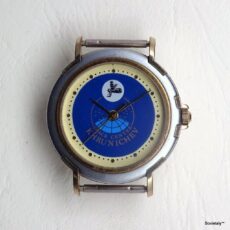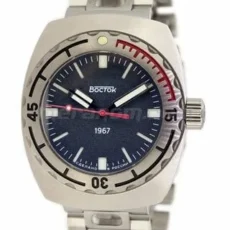The faded dials of Soviet watches, such as the famous Vostok, are a fascinating phenomenon for both collectors and watch enthusiasts. This article explores the chemical and physical causes behind the colour changes of the dials and delves into the craquelé effect, also known as spidering. Additionally, it provides a specific focus on red pigments and their instability.
What is a Faded Dial?
A faded dial is one that has undergone a colour change over time. This phenomenon is particularly evident in the dials of vintage watches, including Soviet models like Vostok. Faded dials are appreciated for their unique appearance and historical charm, often considered signs of authenticity and character.
Nitrocellulose and Colour Changes
Chemical Composition of Nitrocellulose
Nitrocellulose is a polymer obtained through the nitration of cellulose, a process involving the use of nitric acid and sulphuric acid. The chemical reaction replaces the hydroxyl groups in cellulose with nitro groups, creating a highly flammable and versatile compound historically used in lacquers and varnishes for watch dials.
Properties of Nitrocellulose
Nitrocellulose is porous, allowing oxygen and moisture to penetrate the applied film, leading to the oxidation of the underlying metal. This is one of the primary reasons why watch dials can change colour over time, developing what is commonly called “patina” (BEYOND THE DIAL).

Use in Watch Dials
In watch dials, nitrocellulose has been used to create glossy and protective coatings. However, over time, exposure to UV light, oxygen, and moisture leads to the oxidation of underlying materials and the degradation of the varnish itself. This process can cause the varnish to yellow and create an aged appearance, highly appreciated by collectors (BEYOND THE DIAL) (WatchUSeek Watch Forums).
The Craquelé or Spider Effect
Another common defect in vintage watch dials is the craquelé or spider effect. This phenomenon manifests as cracks resembling a spider web and occurs primarily due to defects in the glossy coatings applied to the dials. These cracks form as a result of environmental stressors such as temperature variations and humidity, making each dial unique (SwissWatchExpo).
The Disappearance of Red Colour
A specific phenomenon observed in Vostok watch dials is the disappearance of the red colour. This occurs because the organic red pigments used in the paints were not very UV-resistant. Red paints were often composed of “lake pigments”, pigments formed from an organic dye fixed on an inorganic base, such as calcium salt. These pigments were not stable and tended to fade more quickly than other colours when exposed to sunlight (WatchUSeek Watch Forums).
Examples of Faded Dials in Vostok Watches
Vostok Komandirskie and Amphibia
The Vostok Komandirskie and Amphibia models are classic examples of Soviet watches featuring faded dials. The Komandirskie, known for its durability and water resistance, and the Amphibia, Russia’s first reliable dive watch, are both celebrated for their unique and variable dials. These watches, produced by the Chistopol Watch Factory, are valued for their robustness and iconic design (Vintage Watch Inc) (Hodinkee).
Conclusion
The faded dials of Vostok watches represent a fascinating example of how materials and environmental conditions can interact to create unique and historically significant pieces. Nitrocellulose, with its porosity and susceptibility to oxidation, plays a crucial role in these changes, while defects like craquelé add further character and value. Although red pigments are the first to disappear, leaving clear signs of the passage of time, these defects are now celebrated as marks of authenticity and charm.
For further insights and to discover more models of Soviet watches with faded dials, visit specialised forums and online resources dedicated to vintage watch collecting.
Sources:
- aBlogtoWatch: Tropical Dials Explained By A Vintage Watch Restoration Expert (aBlogtoWatch).
- Bob’s Watches: Aged to Perfection: All About Rolex “Tropical” Dials (Bobswatches.com).
- Beyond the Dial: Collector Guide Understanding Patina on Vintage Varnished Metal Dials (BEYOND THE DIAL).
- WatchUSeek Forum: which dial color withstand fading over time? (WatchUSeek Watch Forums).
- Vintage Watch Inc: Vostok Watches: the Stars of Soviet Vintage (Vintage Watch Inc).
- Hodinkee: In-Depth: The Vostok Amphibia (Hodinkee).





